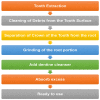Autogenous Tooth Bone Grafts for Repair and Regeneration of Maxillofacial Defects: A Narrative Review
- PMID: 35329377
- PMCID: PMC8955500
- DOI: 10.3390/ijerph19063690
Autogenous Tooth Bone Grafts for Repair and Regeneration of Maxillofacial Defects: A Narrative Review
Abstract
Autogenous tooth graft is an innovative and ingenious technique that employs a stepwise approach and utilizes human teeth as an autogenous source of bone graft. The structure of teeth closely resembles bone, both physically and biochemically, and can be efficiently used for the process as it depicts properties of osteoinduction and osteoconduction. Autogenous tooth bone has characteristics similar to bone grafts in terms of healing potential, physical properties, and clinical outcome. Autogenous tooth graft has shown reasonable promise as a graft material for the regeneration of maxillary and mandibular defects. Autogenous tooth bone graft finds its principal application in sinus and ridge augmentations and for socket preservation before implant placement. Additionally, it can be used successfully for alveolar cleft patients and patients with limited periodontal defects. The overall complication rates reported for autogenous tooth grafts are comparable to other graft sources. However, although long-term results are still underway, it is still recommended as a grafting option for limited defects in the cranio-facial region.
Keywords: alveolar bone loss; bone grafting; dental implants; regeneration.
Conflict of interest statement
The authors declare no conflict of interest.
Figures
Similar articles
-
Maxillary tuberosity block bone graft: innovative technique and case report.J Oral Maxillofac Surg. 2009 Aug;67(8):1723-9. doi: 10.1016/j.joms.2009.03.043. J Oral Maxillofac Surg. 2009. PMID: 19615588
-
Preservation of ridge dimensions following grafting with coral granules of 48 post-traumatic and post-extraction dento-alveolar defects.Dent Traumatol. 2003 Aug;19(4):221-7. doi: 10.1034/j.1600-9657.2003.00164.x. Dent Traumatol. 2003. PMID: 12848717
-
rhBMP-2/ACS grafts versus autogenous cancellous marrow grafts in large vertical defects of the maxilla: an unsponsored randomized open-label clinical trial.Int J Oral Maxillofac Implants. 2013 Sep-Oct;28(5):e243-51. doi: 10.11607/jomi.te04. Int J Oral Maxillofac Implants. 2013. PMID: 24066341 Clinical Trial.
-
Maxillary autogenous bone grafting.Oral Maxillofac Surg Clin North Am. 2011 May;23(2):229-38, v. doi: 10.1016/j.coms.2011.01.003. Oral Maxillofac Surg Clin North Am. 2011. PMID: 21492798 Review.
-
Review of bone graft and implant survival rate : A comparison between autogenous bone block versus guided bone regeneration.J Stomatol Oral Maxillofac Surg. 2022 Apr;123(2):222-227. doi: 10.1016/j.jormas.2021.04.009. Epub 2021 Apr 27. J Stomatol Oral Maxillofac Surg. 2022. PMID: 33930599 Review.
Cited by
-
Lateral Alveolar Ridge Augmentation with Autogenous Tooth Roots and Staged Implant Placement-5-Year Follow-Up Case Series.J Clin Med. 2024 Aug 29;13(17):5118. doi: 10.3390/jcm13175118. J Clin Med. 2024. PMID: 39274332 Free PMC article.
-
Clinical and Radiographic Evaluation of Autologous Platelet-Rich Fibrin With or Without Demineralized Bone Matrix in the Treatment of Grade II Furcation Defects.Cureus. 2023 Aug 30;15(8):e44394. doi: 10.7759/cureus.44394. eCollection 2023 Aug. Cureus. 2023. PMID: 37654905 Free PMC article.
-
Effects of Ibuprofen and Diclofenac Pre-Treatment on Viability and Apoptosis Processes in Human Dental Pulp Stem Cells.Medicina (Kaunas). 2024 May 9;60(5):787. doi: 10.3390/medicina60050787. Medicina (Kaunas). 2024. PMID: 38792973 Free PMC article.
-
Comparing the effect of using calcified autogenous nano dentin particles versus micro dentin particles in the healing of mandibular bony defects in New Zealand rabbits.BMC Res Notes. 2025 Mar 25;18(1):125. doi: 10.1186/s13104-025-07191-6. BMC Res Notes. 2025. PMID: 40134026 Free PMC article.
-
Preoperative Cone Beam Computed Tomography Assessment of Intraoral Autogenous Bone Graft Volumes Linked to Sex and Tooth Condition.Med Sci Monit. 2025 Apr 4;31:e947602. doi: 10.12659/MSM.947602. Med Sci Monit. 2025. PMID: 40181511 Free PMC article.
References
Publication types
MeSH terms
LinkOut - more resources
Full Text Sources
Other Literature Sources
Medical



